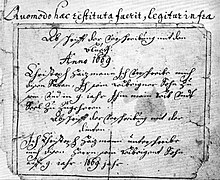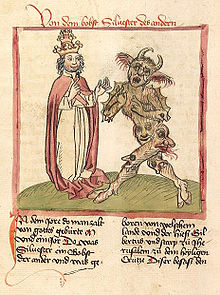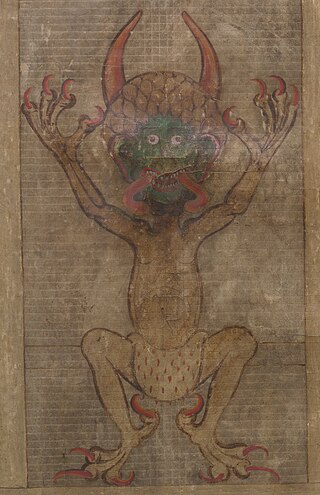
Satan, also known as the Devil, and sometimes also called Lucifer in Christianity, is an entity in Abrahamic religions that seduces humans into sin or falsehood. In Judaism, Satan is seen as an agent subservient to God, typically regarded as a metaphor for the yetzer hara, or "evil inclination". In Christianity and Islam, he is usually seen as a fallen angel or jinn who has rebelled against God, who nevertheless allows him temporary power over the fallen world and a host of demons. In the Quran, Shaitan, also known as Iblis, is an entity made of fire who was cast out of Heaven because he refused to bow before the newly created Adam and incites humans to sin by infecting their minds with waswās.

Faust is the protagonist of a classic German legend based on the historical Johann Georg Faust.
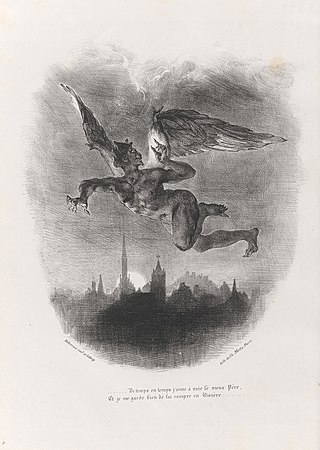
Mephistopheles, also known as Mephisto, is a demon featured in German folklore. He originally appeared in literature as the demon in the Faust legend and has since become a stock character appearing in other works of arts and popular culture.

Christian demonology is the study of demons from a Christian point of view. It is primarily based on the Bible, the interpretation of these scriptures, the writings of early Christianity philosophers, hermits, and the associated traditions and legends incorporated from other beliefs.
Sæmundr Sigfússon, better known as Sæmundr fróði, was an Icelandic priest and scholar.

La Chasse-galerie, also known as "The Bewitched Canoe" or "The Flying Canoe", is a popular French-Canadian tale of lumberjacks from camps working around the Gatineau River who make a deal with the devil, a variant of the Wild Hunt. Its best-known version was written by Honoré Beaugrand (1848–1906). It was published in The Century Magazine in August 1892.

Gorgoroth is a Norwegian black metal band based in Bergen. It was formed in 1992 by guitarist Infernus, who is the sole original member remaining, and has released nine studio albums. Gorgoroth are a Satanic band and have drawn controversy due to some of their concerts, which have featured impaled sheep heads and mock crucifixions. The band is named after the dead plateau of darkness in the land of Mordor from J. R. R. Tolkien's fantasy novel The Lord of the Rings.

Daemonologie—in full Daemonologie, In Forme of a Dialogue, Divided into three Books: By the High and Mighty Prince, James &c.—was first published in 1597 by King James VI of Scotland as a philosophical dissertation on contemporary necromancy and the historical relationships between the various methods of divination used from ancient black magic. It was reprinted again in 1603 when James took the throne of England. The widespread consensus is that King James wrote Daemonologie in response to sceptical publications such as Reginald Scot's The Discoverie of Witchcraft.

Felix Faust is a supervillain appearing in American comic books published by DC Comics. The character first appeared in Justice League of America #10 (1962), created by Gardner Fox and Mike Sekowsky. He is depicted as a mystic sorcerer, obsessed with restoring himself to his former might after being robbed of much of his power during a battle with Doctor Mist. While typically empowered by the demonic powers of a trio of brothers known as the "Demons Three", to whom he sold his soul in a faustian deal, the character also frequently targets other magical entities and objects to strengthen his power, putting him frequently at odds with numerous superhero teams.

Saint Theophilus the Penitent or Theophilus of Adana was a cleric in the sixth century Church who is said to have made a deal with the Devil to gain an ecclesiastical position. His story is significant as it is one of the oldest popular stories of a pact with the Devil and was an inspiration for the Faust legend. Eutychianus of Adana, who claimed to be an eyewitness of the events, is the first to record Theophilus's story.
The Devil, appears frequently as a character in literature and various other media. In Abrahamic religions, the figure of the Devil, Satan personifies evil.
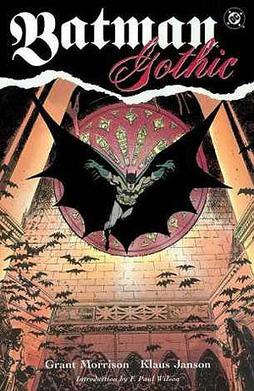
Gothic, also known as Gothic: A Romance, is a 1990 Batman comic book storyline that ran through the Legends of the Dark Knight monthly series and was later compiled into trade paperback form. It was written by Grant Morrison and illustrated by Klaus Janson.

Roger Tiegs, better known by his stage name Infernus, is a Norwegian black metal musician and Satanist. He is the sole founding member and chief ideologist of the black metal band Gorgoroth, formed in 1992, in addition to being the founder and head of Forces of Satan Records. While mainly a guitarist, Infernus has also participated as bassist, drummer and vocalist on several recordings released both by Gorgoroth and other bands.
Faust has inspired artistic and cultural works for over four centuries. The following lists cover various media to include items of historic interest, enduring works of high art, and recent representations in popular culture. The entries represent works that a reader has a reasonable chance of encountering rather than a complete catalog.
This article lists cultural references to Mephistopheles, the fictional devil from Faust and Doctor Faustus who has been used in other pieces of literature, film, comics and music.

Werewolf witch trials were witch trials combined with werewolf trials. Belief in werewolves developed parallel to the belief in European witches, in the course of the Late Middle Ages and the Early Modern period. Like the witchcraft trials as a whole, the trial of supposed werewolves emerged in what is now Switzerland during the Valais witch trials in the early 15th century and spread throughout Europe in the 16th, peaking in the 17th and subsiding by the 18th century. The persecution of werewolves and the associated folklore is an integral part of the "witch-hunt" phenomenon, albeit a marginal one, accusations of lycanthropy involved in only a small fraction of witchcraft trials.
"Daniel and the Devil" is an 1888 short story by the American journalist and poet Eugene Field. Similar in subject matter and setting to other American "pact with the Devil" or Faust stories, such as "Young Goodman Brown" by Nathaniel Hawthorne and Washington Irving's "The Devil and Tom Walker," Field's story varies significantly in allowing the Faust character (Daniel) to escape from the bargain.
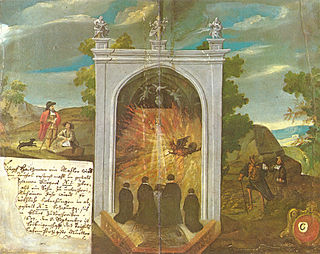
The idea of making a deal with the devil has appeared many times in works of popular culture. These pacts with the Devil can be found in many genres, including: books, music, comics, theater, movies, TV shows and games. When it comes to making a contract with the Devil, they all share the same prevailing desire, a mortal wants some worldly good for their own selfish gain, but in exchange, they must give up their soul for eternity.

Newes from Scotland - declaring the damnable life and death of Dr. Fian, a notable sorcerer is a pamphlet printed in London in 1591, and likely written by James Carmichael, who later advised King James VI on the writing of his book Daemonologie. It describes the North Berwick witch trials in Scotland and the confessions given before the king, and was published in Daemonologie by King James in 1597.

John Fian was a Scottish schoolmaster in Prestonpans, East Lothian and purported sorcerer. He confessed to have a compact with the devil while acting as register and scholar to several witches in North Berwick Kirk. He was accused of bewitching townsfolk, preaching witchcraft, and, along with Agnes Sampson and others, raising storms to sink the fleet of King James VI of Scotland and his wife Anne of Denmark as they returned from Copenhagen, having been married in Oslo. He along with several other witches were arrested, examined and put to torture, in what would become known as the North Berwick witch trials.

